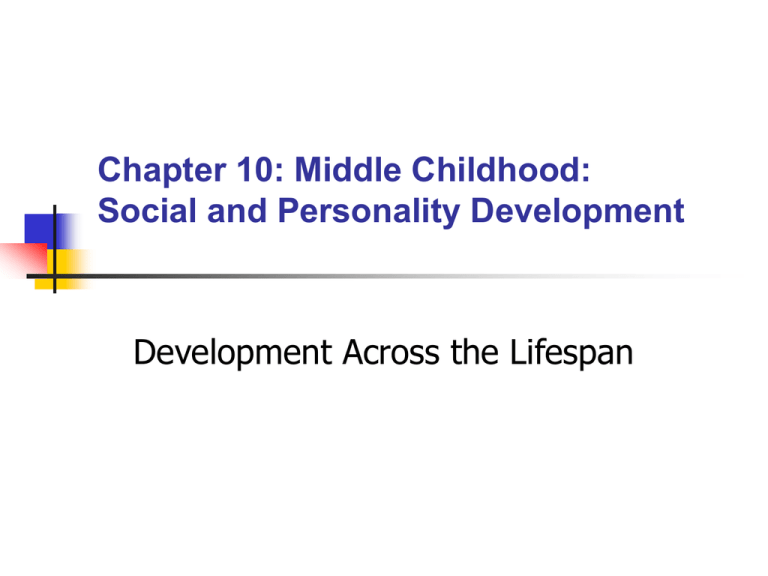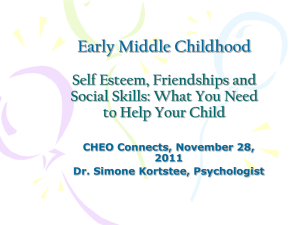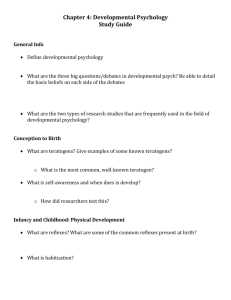Chapter 10: Middle Childhood: Social and Personality Development
advertisement

Chapter 10: Middle Childhood: Social and Personality Development Development Across the Lifespan Social & Personality Development: Understanding Oneself in Middle Childhood Children in middle childhood are struggling to understand who they are, and continue to explore answers to the question “Who am I?” The Developing Self ~ During middle childhood, children begin to view themselves less in terms of external physical attributes and more in terms of psychological traits. Children realize they are good at some things and not so good at others. Their self-concepts become divided into personal and academic spheres… As children get older, their views of self become more differentiated. (The Developing Self, continued) Children use SOCIAL COMPARISON, comparing themselves to the abilities, expertise, and opinions of others. Festinger proposed that when objective measures are absent, people rely on social reality to evaluate themselves (understanding that comes from studying how others act, think, feel, and view the world). Children look to others who are similar to themselves. (Social comparison, continued) Sometimes children make downward social comparisons with others who are obviously less competent or successful to raise or protect their self-esteem. This explains why some students in elementary school have very high self esteem in spite of the fact that are in special education classes Big fish in a small pond Psychosocial Development: Industry versus Inferiority According to Erik Erikson, middle childhood encompasses the INDUSTRY-VERSUSINFERIORITY STAGE, the period from ages 6 to 12 characterized by a focus on efforts to attain competence in meeting the challenges presented by parents, peers, school, and the other complexities of the modern world. (Psychosocial Development: Industry versus Inferiority, continued) Success in this stage is evidenced by feelings of mastery, proficiency, and confidence. Difficulties lead to feelings of failure and inadequacy, and to withdrawal from academics and socialization with peers Attaining a sense of industry during middle childhood has lasting consequences! High levels of childhood industry associated with adult success (more so than intelligence and family background!) Self esteem: Evaluating the self Children evaluate themselves in terms of physical and psychological characteristics, but they also think of themselves as being good or bad (involves emotions) SELF-ESTEEM, an individual's overall and specific positive and negative selfevaluation, develops in important ways during middle childhood. Self esteem develops in important ways during middle childhood… Children increasingly compare themselves to others. Children are developing their own internal standards. Self-esteem, for most children, increases during middle childhood. Children with low self-esteem may become enmeshed in a cycle of failure that is difficult to break. A cycle of Low Self-Esteem If a child has low self-esteem and expects to do poorly on a test, she may experience anxiety and not do as well, which confirms the negative self view. Parents can break this cycle a warm and supportive style. Self esteem, continued… Early research showed that the self-esteem of minority groups was lower than majority groups' due to prejudice and discrimination. Tajfel (French psychologist) showed that if minority groups do not accept the views of their group by the majority group, their self-esteem will not suffer. Societal attitudes favoring group pride, ethnic awareness, and sensitivity have resulted in more similar levels of self esteem in members of different ethnic groups Self efficacy: Building expectations of the self “Will I do well in the spelling bee?” “I wonder if I would be good at playing the flute?” “Do I have a chance at winning the award for best science project?” ~ These type of questions resemble those that children commonly ask themselves during the elementary school years. The way children answer is based on their levels of self efficacy. (Self efficacy, continued) SELF-EFFICACY refers to the learned expectations that one is capable of carrying out a behavior or producing a desired outcome in a particular situation. Self-efficacy is crucial to children's success because it motivates greater effort and persistence in the face of a challenging task. High self-efficacy is related to success in academics and athletics. Observing others' success, failure, praise, and encouragement are other sources of self-efficacy. Social & Personality Development: Morals in Middle Childhood Different theories of moral development exist Moral development is often used as a measure of social & personality development in middle childhood, albeit in different ways… An Overview Morals in Middle Childhood Moral Dilemmas Cancer drug question in text Should you steal the drug? Developmental psychologist Lawrence Kohlberg asserts that the way that children answer this question reveals central aspects about their morality and sense of justice. Information about stage or moral development Information about cognitive developmental level Lawrence Kohlberg Born: 1927, Bronxville, NY Died: 1987, Boston, MA Education: PhD, U. of Chicago Accomplishments: Major contributor to the field of moral development and reasoning; Published major work in 1981, Essays on Moral Development. Kohlberg’s stages of moral reasoning Lawrence Kohlberg suggests that people pass through a series of stages in the development of moral reasoning. (summary in text table) Preconventional Morality (stages 1 & 2) is where people follow unvarying rules based on rewards and punishments (children in MIDDLE CHILDHOOD are at this level!) (Kohlberg’s stages of moral reasoning, continued) Conventional Morality (stages 3 & 4) is where people approach problems in terms of their own position as good, responsible members of society. Postconventional Morality (stages 5 & 6) is where universal moral principles are invoked and considered broader than a particular society. Some key points related to Kohlberg’s theory Kohlberg assessed people's moral reasoning using moral dilemmas. According to Kohlberg, people move through these stages in a fixed order. Middle childhood is at stage 1 & 2, the preconventional stage, because of the limits of children's cognitive abilities. (key points related to Kohlberg’s theory, continued) Kohlberg's theory is a good account of moral judgment but not adequate at predicting moral behavior. Another problem: the theory is based on data from males, and is inadequate in describing the moral development of females! Moral Development in Girls Carol Gilligan’s theory of moral development Carol Gilligan suggests that the way boys and girls are raised in our own society leads to differences in moral reasoning. Kohlberg's theory is inadequate and places girls' moral reasoning at a lower level than boys'. Boys view morality primarily in terms of justice and fairness. Girls see morality in terms of responsibility and compassion toward individuals and a willingness to sacrifice for relationships. Carol Gilligan Born: 1937- New York Current: Professor of Gender Studies, Harvard University Education Ph.D., Harvard University Achieve ments: Challenged Lawrence Kohlberg's theories of moral development on the basis of gender bias; Pioneer in the research on moral development of women; One of Time Magazine's 25 most influential people of 1996. Gilligan sees morality in girls developing in 3 stages. Orientation toward individual survival - where females concentrate on what is practical and best for them. Goodness as self-sacrifice - where females think they must sacrifice their own wishes to what others want. Morality of nonviolence - women come to see hurting anyone as immoral, including themselves. ~The highest levels of morality are represented by compassionate concern for the welfare of others Relationships in Middle Childhood: Building Friendships Children’s development is seriously effected by the formation of friendships in middle childhood ~~ Friendships influence children's development in several ways. The influence of friendships on children’s development, continued Friends provide information about the world and other people. Friends provide emotional support and help kids to handle stress. Friends teach children how to manage and control their emotions. The influence of friendships on children’s development, continued Friends teach about communication with others. Friends foster intellectual growth. Friends allow children to practice relationship skills Status among school age children Children's friendships show clear hierarchies in terms of STATUS, the evaluation of a role or person by other relevant members of a group. High status children have greater access to resources such as games, toys, books, and information. High status children tend to form friendships with high status children and low status children form friendships with other lower status children Status among school age children, continued Lower status children tend to follow the lead of higher status children. Popularity is a reflection of a child's status. High status children are more likely to form exclusive and desirable cliques and tend to play with a greater number of children than lower status children. Lower status children are more likely to play with younger or less popular children. During the middle childhood period, children’s ideas about friendship undergo changes… According to developmental psychologist William Damon, children's friendships go through three stages. Stage 1 - ages 4-7. Children see friends as like themselves. Children see friends as people to share toys and activities with. Children do not take into account personal traits. Damon’s 3 stages of friendship, continued Stage 2 - ages 8-10. Children now begin to take other's personal qualities and traits into consideration. Friends are viewed in terms of the kinds of rewards they provide. Friendships are based on mutual trust. Damon’s 3 stages of friendship, continued Stage 3 - ages 11-15. Friendships become based on intimacy and loyalty. Friendships involve mutual disclosure and exclusivity. Children also develop clear ideas about the behaviors they seek in friends… Behaviors favored in friends during middle childhood Most-liked Least-liked Sense of humor Verbal aggression Nice/friendly Dishonesty Helpful Critical Complementary Greedy/bossy Sharing Teasing Loyalty Physical aggression Table in text What makes a child popular during middle childhood? Popular children have SOCIAL COMPETENCE, the collection of individual social skills that permit individuals to perform successfully in social settings. More characteristics common to popular children They are helpful and cooperative. They have a good sense of humor. They have good emotional understanding. They ask for help when necessary. They are not overly reliant on others. They can adapt to social situations. Popularity issues in development, continued Lack of popularity may take two forms. NEGLECTED CHILDREN receive relatively little attention from their peers in the form of either positive or negative interaction. REJECTED CHILDREN are actively disliked and their peers may react to them in an obviously negative manner. Some characteristics of unpopular children… Unpopular children lack social competence. They may act immature or inappropriately silly. They may be overly aggressive and overbearing. They may be withdrawn or shy. They may be unattractive, handicapped, obese, or slow academically. Popularity issues in development, continued Another factor that relates to children's popularity is skill at SOCIAL PROBLEM SOLVING, the use of strategies for solving social conflicts in ways that are satisfactory both to oneself and to others. Developmental psychologist Kenneth Dodge argues that successful social problem solving proceeds through steps that correspond to children's information-processing strategies: Dodge’s social problem solving steps Find and identify relevant social cues. Interpret and evaluate the social cues. Determine possible problem-solving responses. Evaluate responses and their possible consequences. Choose a response. Knowing these steps allows adults to intervene and target a child's specific deficits. Problemsolving Steps Children’s problemsolving steps proceed through several steps involving different information processing strategies (Dodge, 1985) Several programs have been developed to teach children social skills. Skills in holding a conversation Decoding facial expressions to increase sensitivity to others’ emotions and moods These programs have led to more acceptance by peers and improved skill at making friends and getting along with teachers Gender & Friendships in Middle Childhood Avoidance of the opposite sex becomes very pronounced during middle childhood. Children's friendships are almost entirely sex-segregated. (Gender & Friendships in Middle Childhood, continued) When the sexes interact it is called "border work", often romantic helps emphasize the clear boundaries between the sexes Lays the groundwork for future interactions during adolescence Girls threatening to kiss boys Boys luring girls into chasing them The nature of boys' and girls' friendships are different. Boys have larger networks of friends than girls do. Boys have a strict DOMINANCE HIERARCHY, which is composed of rankings that represent the relative social power of those in a group hierarchy. (The differing nature of boys' and girls' friendships, continued) Boys attempt to maintain and improve their status in the hierarchy, which makes for a style of play known as restrictive play where interactions are interrupted when status is challenged. Girls focus on one or two "best friends" of relatively equal status. (The differing nature of boys' and girls' friendships, continued) Conflicts among girls are solved by compromise, ignoring the situation, or giving in. Girls, however, can be confrontational with other girls not their friends or with boys. Girls' language is less confrontational and direct than boys'. Promoting Cross-race friendships Children's closest friends tend largely to be with others of the same race. Research supports the notion that contact between majority and minority group members can reduce prejudice and discrimination. Contact must occur in equal status settings. Contact is enhanced through cooperative activities that are important. The contact must promote equality and disconfirm negative stereotypes. The Family and School: Shaping Children in Middle Childhood The structure of the family has been changing dramatically over the past several decades with serious implication for the development of children! Increase in the # of parents working outside the home Rise in single parent families Societal environment Escalating divorce rate The Consequences of Divorce Only 1/2 of children in the U.S. will pass through childhood living with both parents, each of whom has been married only once! School-age children tend to blame themselves for the breakup. Both children and parents may show several types of psychological maladjustments for 6 months to 2 years after a divorce. anxiety depression sleep disturbances phobias More about the impact of divorce on school age children… Most children will live with their mother and the mother-child relationship may decline temporarily. After 18 months to 2 years, most children return to their predivorce psychological adjustment. Twice as many children of divorced parents require psychological counseling as do children from intact families. (impact of divorce on school age children, continued) Divorce brings a decline to both parents' standard of living— especially the mother’s! For some children, living in a home with an unhappy marriage and which is high in conflict has stronger negative consequences than a divorce. For many children, the aftermath of divorce includes remarriage of 1 or both parents BLENDED FAMILIES include a remarried couple that has at least one stepchild living with them. Experts predict that by 2000, over 50 % of children born in the last decade will be stepchildren.! Living in a blended family involves role ambiguity, in which roles and expectations are unclear More about BLENDED FAMILIES School-age children often adjust relatively smoothly to a blended family. financial status of family improves more people to share household chores more social interaction and attention ~ Some children do not adjust well,especially if the new relationship is threatening. (have to share parent’s attn with a stepsibling) When both parents work, how do children fare? In most cases, children whose parents both work fulltime outside the home fare quite well. Women who are satisfied with their lives tend to be more nurturing at home. Research shows that children whose parents both work spend essentially the same amount of time with the family, in class, with friends, and at home as children who have a parent at home. Children may spend more time with their father if their mother works. How Kids Spend Their Time The amount of time kids spent on some activities has remained constant over the years, and others have changed significantly. Think about what might account for these changes. Children’s success in families where both parents work is often based on the quality of substitute care. For many children, no care is available when they return home from school SELF-CARE CHILDREN are youngsters who let themselves into their homes after school and wait alone until their parents return from work, previously known as latchkey children (but now not because of negative connotations). SELF-CARE CHILDREN, continued The consequences of being a latchkey child are not necessarily harmful. Some children report being lonely. Some children develop a sense of independence and competence. Some research shows latchkey children have higher self-esteem because they are helping the family. Single parent families… Almost one-quarter of all children under 18 in the U.S. live with only one parent. Numbers are higher for minority children. 60% of African-American children live in single parent homes. 35% of Hispanic children live in single parent homes. Single parent families, continued In the majority of cases, the single parent is the mother. The consequences of living in a single parent home depend on: whether the other parent ever lived at home economic status Increase of Single Mothers, 1940-1993 The number of mothers without spouses has increased significantly over the last 50 years. The consequences of group care: Orphanages in the 90’s The term "orphanage" has been replaced by group home or residential treatment center, which are group homes used for youngsters whose parents are no longer able to care for them adequately. The number of children in group care has grown over 50 % since 1987. About three-quarters of children in group homes are victims of abuse and neglect. Orphanages in the 90’s, continued Most will eventually return home, however, onefourth will be in group care throughout childhood. Experts disagree on the advantages and disadvantages of group care. Some see them as a solution to unwed mothers who become dependent on welfare. Many who work in these homes say they cannot provide adequate love and support as a family could. They cost ten times as much as foster care or welfare (e.g., $40,000/yr.). School: The Impact of the Academic Environment on Development in Middle Childhood During the school year, more of the day is spent in a classroom than anywhere else and schools have a large influence on children's lives. Bernard Weiner proposed a theory of motivation based on people's ATTRIBUTIONS, their understanding of the reasons behind their behavior. Weiner’s theory of attributions… People attempt to explain their behavior in one of three ways. Whether the cause is internal (dispositional) or external (situational). Whether the cause is stable or unstable. Whether the cause is controllable or uncontrollable. The attributions children make about their successes and failures in school have important implications for their performance. If success is internal, children feel pride. If failure is internal, children feel shame. If success or failure is attributed to stable characteristics, children can expect similar results in the future. The implications of children’s attributions, continued If success or failure is attributed to unstable characteristics (such as luck), their expectations for the future are unknown. If children feel failure was within their control, they feel anger. If children feel failure was due to uncontrollable reasons, they fell sadness or pity. Race, ethnicity, and socioeconomic status have strong influences on attributions of success and failure. African-American children are less likely to attribute success to internal causes, feeling that prejudice and discrimination are to blame. Women tend to attribute failure to low ability and success to luck. In Asian countries, academic success is perceived as being caused by hard work. Mothers’ Beliefs in Children’s Abilities Compared to mom’s in Taiwan & Japan, U.S. moms were less likely to believe that all kids have the same degree of inborn ability. Think about how this affects schooling. Subjects responded to a 7 point scale, where 1 was equivalent to strongly disagree and 7 was strongly agree. How expectancies influence children’s behavior… Research suggests a TEACHER EXPECTANCY EFFECT, the cycle of behavior in which a teacher transmits an expectation about a child and thereby actually brings about the expected behavior. Teacher expectancy is an instance of self-fulfilling prophecy, in which a person's expectation is capable of bringing about an outcome. Teacher's expectations are conveyed to the child by complex verbal and nonverbal cues. Classroom social-emotional climate. smiling warmth feedback more positive feedback to high expectation children more criticism to low expectation children Teacher's expectations and their influence on the classroom climate, continued Input to children more opportunities to perform well for high expectation children more difficult material for high expectation children Output from teachers more contact with high expectation children more opportunities to respond in class for high expectation children. Teacher Expectation and its Effect on Student Performance Educators in many elementary schools in the united states are setting a new educational trend: working to improve students emotional abilities Schools are beginning to teach techniques to increase students‘ EMOTIONAL INTELLIGENCE, the set of skills that underlie the accurate assessment, evaluation, expression, and regulation of emotions. Critics suggest that nurturance of emotional intelligence is best left to students‘ families and that schools should concentrate on the basics. Most consider emotional intelligence worthy of nurturance. ~What do you think? Should schools teach emotional intelligence? Don’t forget to keep up with your reading!








